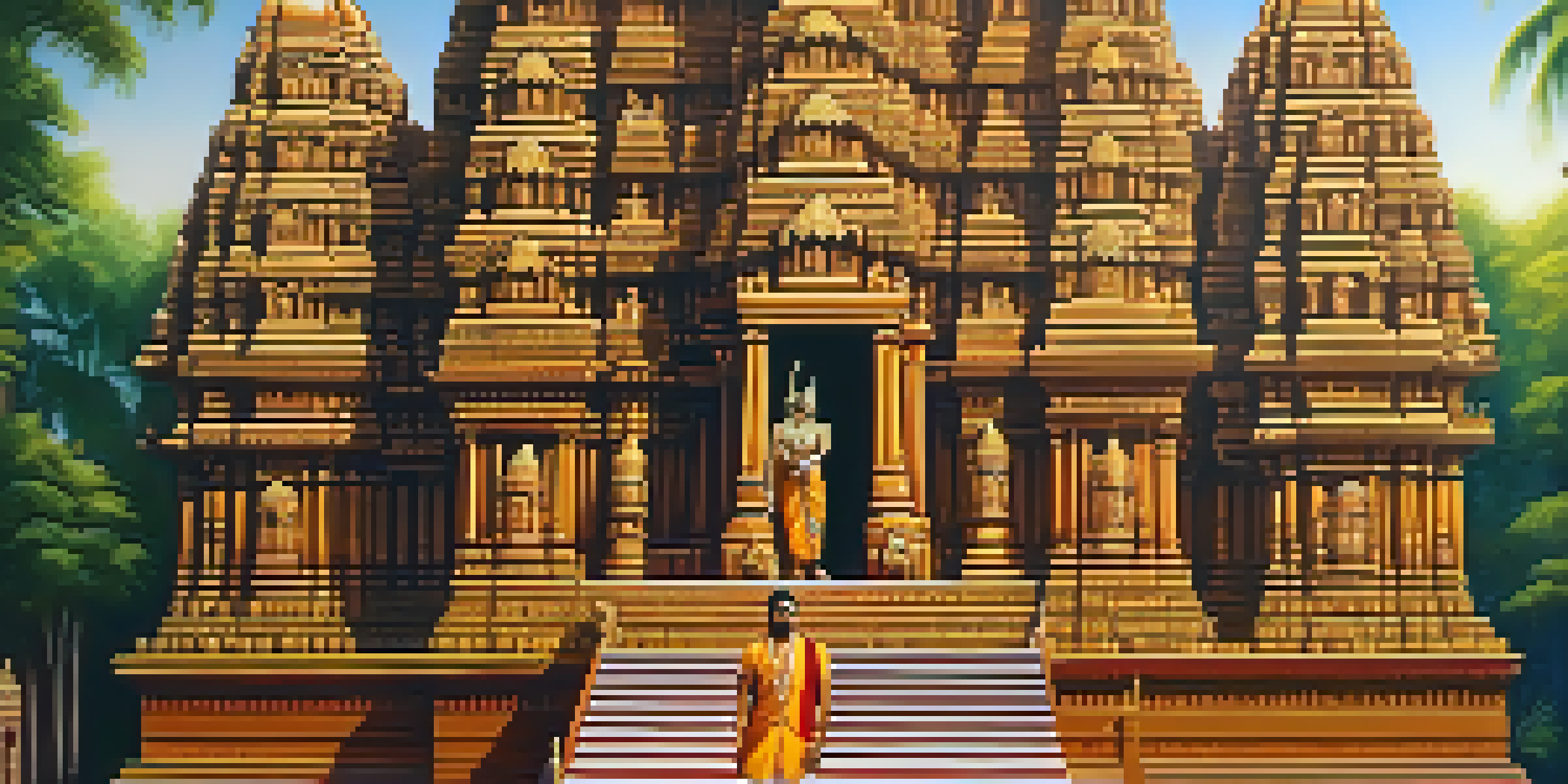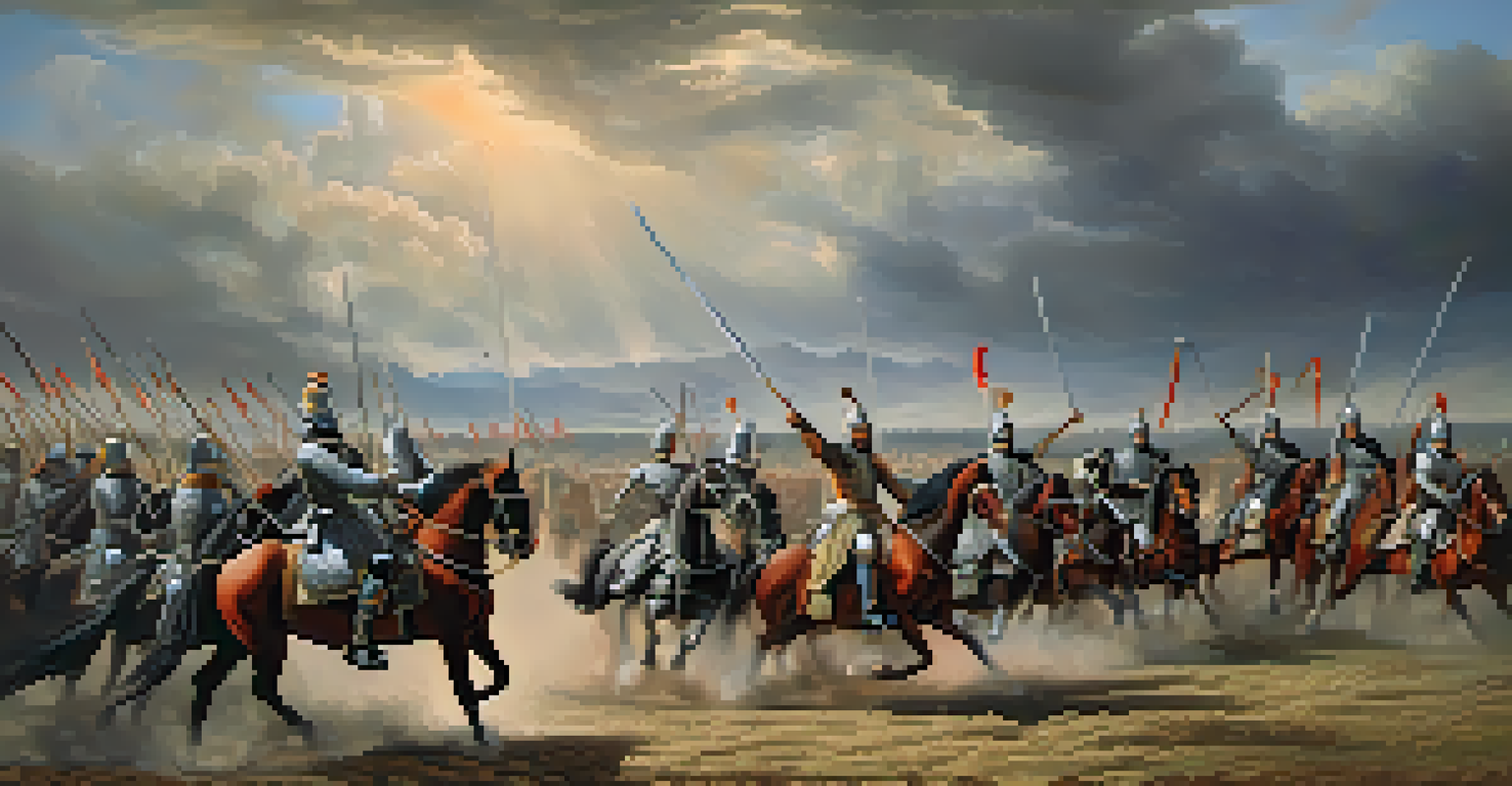Significant Historical Figures in India's Reenactment Scene

The Role of Raja Raja Chola in Reenactments
Raja Raja Chola, a prominent king from the Chola dynasty, has become a significant figure in India's reenactment scene. His reign, which spanned from 985 to 1014 AD, was marked by military conquests and cultural advancements. Reenactors often bring his story to life, showcasing his innovations in temple architecture and administration.
History is not a burden on the memory but an illumination of the soul.
Through vivid portrayals, participants highlight his contributions to the Tamil culture and the establishment of a powerful naval presence in Southeast Asia. These reenactments not only celebrate Chola's legacy but also educate audiences about the historical context of his era. It’s a beautiful blend of art and history that captivates viewers.
Moreover, reenacting Chola's life offers a glimpse into the rich traditions of the South Indian community, fostering a sense of pride and cultural identity. This connection between the past and present is essential for preserving the history that shapes modern India.
Maharana Pratap's Legacy in Historical Reenactments
Maharana Pratap, the valiant king of Mewar, stands as a symbol of bravery and resistance against Mughal rule. His life, filled with battles and triumphs, is a favorite among reenactors who want to honor his legacy. The iconic Battle of Haldighati, fought in 1576, is often recreated to showcase his fearless spirit and tactics.

These performances not only dramatize the historical events but also instill a sense of patriotism among participants and viewers alike. By donning armor and wielding traditional weapons, reenactors immerse themselves in the life of Maharana Pratap, creating a powerful emotional connection. This participation fosters a deeper understanding of the sacrifices made for independence.
Reenactments Connect Us to History
Historical reenactments in India engage communities by bringing the stories of iconic figures to life, fostering a deeper understanding of cultural heritage.
Furthermore, the reenactments serve as a platform to discuss broader themes of valor, loyalty, and national pride, making history relatable and engaging. The legacy of Maharana Pratap transcends time, reminding everyone of the importance of courage and resilience.
Rani Lakshmibai: A Symbol of Female Empowerment
Rani Lakshmibai of Jhansi is celebrated as a fierce warrior queen who played a crucial role in the 1857 uprising against British colonial rule. Her leadership and valor inspire reenactors who seek to portray her life and the struggles of women in Indian history. Through these reenactments, many discover her incredible story of bravery and empowerment.
The greatest glory in living lies not in never falling, but in rising every time we fall.
Participants often highlight her strategic acumen and the emotional depth of her fight for her kingdom. By reenacting pivotal moments of her life, they bring attention to the often-overlooked contributions of women in India's freedom struggle. This representation serves as an inspiration for modern audiences, especially women, to recognize their strength.
Additionally, Rani Lakshmibai’s story encourages discussions around gender roles and the importance of female representation in history. It empowers individuals to reflect on the strides made and those still needed toward gender equality.
The Impact of Bhagat Singh in Modern Reenactments
Bhagat Singh, a revolutionary figure in India's fight for independence, remains a prominent icon in the reenactment scene. His youthful passion and commitment to social justice resonate with many, making his life a compelling subject for dramatization. Reenactors often depict key events, such as his trial and execution, to highlight his revolutionary ideology.
Through these performances, participants aim to educate audiences about the sacrifices made by young freedom fighters. They emphasize the importance of standing up against oppression and inspire viewers to reflect on their own roles in society. Bhagat Singh's legacy serves as a powerful reminder of the impact of individual actions on collective change.
Empowerment Through Historical Figures
Figures like Rani Lakshmibai and Bhagat Singh serve as powerful symbols of courage and resistance, inspiring modern audiences to reflect on their struggles and values.
Moreover, these reenactments foster a sense of community and encourage discussions about current social issues, making history relevant and inspiring. Bhagat Singh’s story is not just about the past; it continues to inspire movements for justice and equality today.
Tipu Sultan: The Tiger of Mysore in Reenactments
Tipu Sultan, known as the 'Tiger of Mysore,' is another historical figure frequently portrayed in reenactments across India. His relentless fight against British colonial forces during the Anglo-Mysore Wars showcases his bravery and innovative military strategies. Reenactors often depict his battles, highlighting his use of technology and guerrilla tactics.
These reenactments allow audiences to appreciate Tipu Sultan’s contributions to resistance and nationalism. By immersing themselves in his story, participants can better understand the complexities of colonial history and the struggles faced by indigenous leaders. It also brings forth discussions on the need for strategic thinking in the face of adversity.
Additionally, the performances foster a sense of cultural pride, reminding audiences of India's rich heritage. Tipu Sultan’s legacy encourages people to learn from the past while forging a path toward a united future.
The Influence of Mahatma Gandhi on Reenactments
Mahatma Gandhi, known as the Father of the Nation, has inspired countless reenactments that celebrate his philosophy of non-violence and civil disobedience. His leadership during the Indian independence movement emphasizes the power of peaceful protests. Reenactors often bring to life significant events like the Salt March to showcase Gandhi's role in mobilizing the masses.
These performances not only highlight Gandhi's strategies but also encourage discussions on the importance of peaceful resistance in today’s world. By embodying his principles, participants promote values of tolerance, understanding, and unity. Gandhi's teachings resonate deeply, especially in a time where conflicts often arise.
Future of Reenactments Looks Bright
As technology evolves and community involvement grows, India's historical reenactment scene is poised to educate and inspire future generations effectively.
Moreover, reenacting Gandhi's life serves as a reminder of the strength found in non-violent action, urging audiences to consider how they can apply these principles in their own lives. His legacy continues to inspire movements worldwide, making these reenactments both educational and impactful.
The Cultural Significance of Reenactments in India
Reenactments in India serve as a vibrant tapestry that weaves together history, culture, and education. They provide a platform for people to engage with their heritage in a dynamic way. By immersing themselves in the lives of historical figures, participants foster a deeper connection to their roots and cultural identity.
These events also encourage community participation, bringing together people from diverse backgrounds to celebrate shared history. The collective experience of reenacting significant moments creates bonds and fosters dialogue about the past, present, and future. It’s a unique way to ensure that history is not just remembered but actively lived.

Furthermore, reenactments contribute to preserving history in a manner that textbooks alone cannot achieve. They make learning engaging and accessible, allowing audiences to experience history through the eyes of those who lived it. This cultural significance ensures that the stories of India’s past continue to inspire future generations.
The Future of India's Historical Reenactment Scene
As interest in historical reenactments grows, the future of this cultural phenomenon in India looks promising. New technologies, such as virtual reality and digital storytelling, are beginning to enhance the way historical narratives are shared. This evolution opens up exciting possibilities for engaging younger audiences and broadening the reach of reenactments.
Moreover, as more people recognize the importance of preserving history, community involvement is likely to increase. Local groups and organizations are forming to promote reenactment events, ensuring that diverse stories are told and celebrated. This grassroots approach helps keep the spirit of historical figures alive, fostering a sense of pride and identity.
Ultimately, the future of India's reenactment scene lies in its ability to adapt while remaining true to its roots. By embracing innovation and community engagement, historical reenactments will continue to educate, inspire, and connect generations to come.